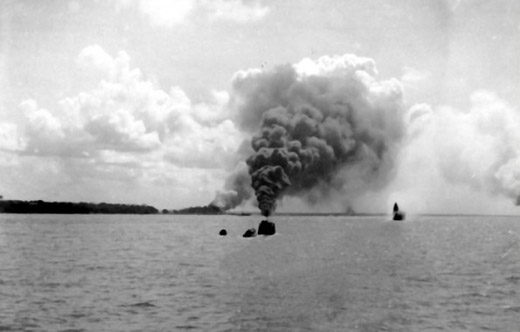Air Operations, East Indies
During the afternoon 9 5th Air Force B-17s bomb Japanese ships off Bali claiming hits on 3 cruisers, a destroyer and a transport. Ship identification from the air was notoriously bad in the early stages of the war as smaller craft were frequently identified as bigger warships. There were no Japanese warships damaged on this day.
In other action, 30 Japanese bombers attack the Java/Bandoeng Airdrome and destroy 2 5th Air Force B-17s and server Dutch Air Force fighters on the ground. A Japanese bomber attack against the Java/Singosari Airdrome is deterred by 17th Provisional Pursuit Squadron P-40s. No Japanese bombers are downed, but 5 A6M escorts are against a loss of 3 P-40s.
[Australia
One hundred and fifty carrier-borne aircraft attack Darwin in Northern Australia, damaging the harbor installations and sinking 12 warships including the US destroyer Peary (DD-226) and damaging 4 others. Among civilians 240 people are killed and 150 are injured. Aboard the ships 172 are killed and 349 are injured. Four carriers from the Pearl Harbor force lead the attack under the command of Adm Nagumo.
US Destroyer Peary On Fire |
 |
Battle of the Atlantic
- Shipping in Port of Spain, Trinidad is attacked by U-161. Damaged are the American steamer Mokihana (7460t) and the British tanker British Consul (6940t). British troopships are temporarily diverted elsewhere for refueling.
- U-432 sinks the British steamer Miraflores (2158t) about 50 miles east of Atlantic City, New Jersey with the loss of her entire crew of 34.
- U-128 sinks the American tanker Pan Massachusetts about 20 miles off Cape Canaveral, Florida with the loss of 20 of her crew. 18 survivors make it on board the British tanker Elizabeth Massey.
- U-96 sinks the British steamer Empire Seal (7965t) southeast of Sable Island with the loss of 1 crewman. 56 survivors are picked up by the British CAM ship Empire Flame.
Britain, Politics
Churchill announces changes in his War Cabinet, Sir Stafford Cripps, formerly ambassador in Moscow, replaces Arthur Greenwood as Lord Privy Seal. ?and Sir Kingsley Wood. Attlee becomes Deputy Prime Minister and Dominions Secretary. Beaverbrook leaves the government.
[Burma
The Japanese cross the Bilin River near Bilin and attack the 17th Indian Div on the flank forcing it to retire. Mandalay is bombed for the first time.
[Canada, Home Front
The Canadian Parliament votes to begin conscription.
[Dutch East Indies
The Japanese invade the island of Bali, east of Java. The British and Dutch destroy bridges and military installations. A confused naval engagement known as the Battle of Badoeng Strait begins in the evening and continues into the next day. This encounter is between the escort vessels of a Japanese convoy carrying infantry through the Strait of Lombok and an Allied squadron under the Dutch Rear-Adm Karel Doorman. The Allies lose a Dutch destroyer while 2 Dutch cruisers and 1 American destroyer, the Stewart (DD-224), is damaged. The Japanese have only 1 destroyer damaged.
Japanese troops land on the Portuguese island of Timor. Tokyo says the action is taken in self-defense and that its forces will withdraw when the area is secure. The neutral Portuguese accept the occupation.
[Germany, Home Front
The German press is criticized by the Reich Press Secretary for publishing stories about Churchill which are too positive and may cause the German population to believe in his leadership. It is urged to stress that he is a liar and is conducting the war like an amateur.
[Malta
The island continues receiving daily attacks from Axis aircraft.
[Pacific
- In Japanese carrier based air attacks on Port Darwin, Australia, the American destroyer Peary, the British tanker British Motorist (6891t), the British steamers Zealandia (6683t) and Neptunia (5592t), the American steamer Mauna Loa (5436t) and the British army transport Meigs (7358t) are sunk. 80 on board the Peary are lost, the British Motorist loses 2 crewmen, Zealandia 3, Neptunia 45, Mauna Loa 5 and Meigs 2.
- The American steamer Don Isidro (3261t) is badly damaged by Japanese bombing northwest of Bathurst Island near Darwin. She is beached and considered a total loss. 11 of her crew are lost, 73 are rescued by the Australian minesweeper Warrnambool. In the same attack the American steamer Florence D (2638t) is sunk with the loss of 3 of her crew. 34 survivors are rescued by the Warrnambool and the British lugger St Francis.
United States, Command
Gen Eisenhower is appointed Chief of the War Plans Div of the US Army General Staff. In this capacity he will advocate the intensification of Operation Bolero, the buildup of US forces in Britain, and press for the development of Operation Sledgehammer, a cross-Channel invasion of Europe from Britain.
[United States, Home Front
Pres Roosevelt signs Executive Order 9066 giving the secretary of war powers to exclude persons from military areas. This legislation is directed at the nation's Japanese-American population, which has faced growing public hostility since Pearl Harbor. The US Army subsequently removes 11,000 Japanese-Americans from the Pacific coast to camps in Arkansas and Texas for the war's duration. It was feared they would aid the Japanese in an attack on the West coast. Such fears prove groundless, but more thatn 112,000 people are interned. Not a single Japanese-American, however, is convicted of spying for Tokyo during the war. Others go on to serve with distinction in the US armed forces, winning many awards for gallantry.
Japanese Americans Are Moved to Internment Camps |
 |
Vichy, Politics
(20th?)Gen Gamelin and two former prime ministers of France, Reynaud and Blum are put on trial at Riom by the Vichy authorities, charged with being responsible for the French defeat in 1940. The defendants are largely successful in shifting the blame as it appears from the evidence toward the whole of the military establishment. This is a victory because a large part of the Vichy government is taken from such sections of society. The trial is never concluded.
[